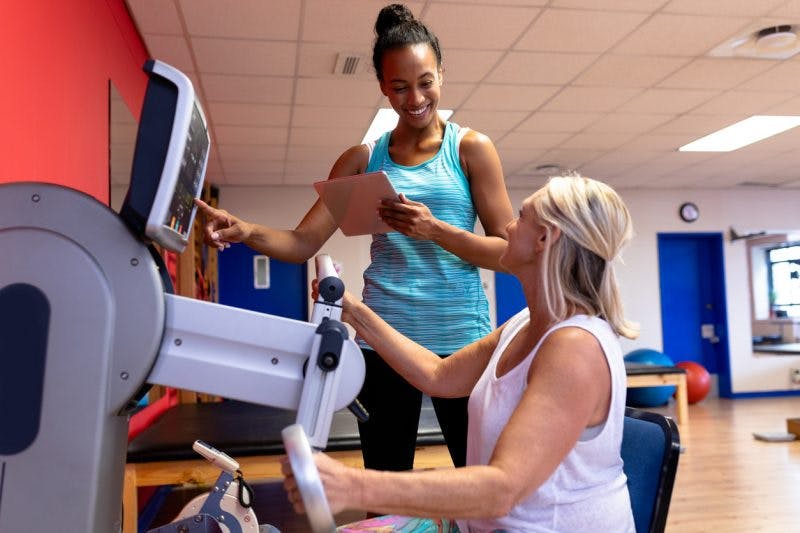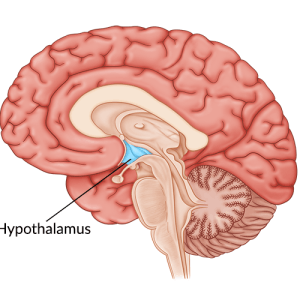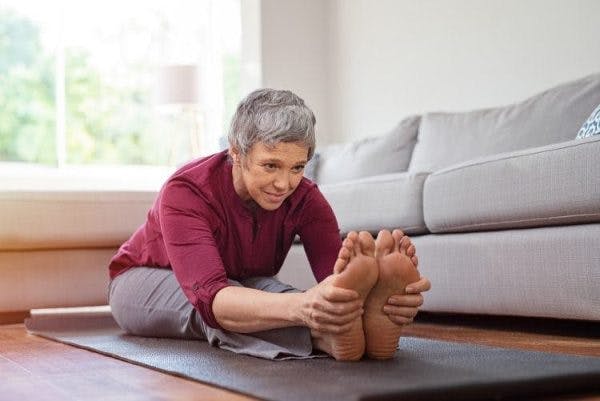If you want to regain movement and strength after a traumatic brain injury, one of the best things you can do is participate in physical therapy. Physical therapy helps individuals improve their mobility by utilizing various interventions that target the affected muscles.
This article will discuss some of the most effective physical therapy interventions for recovering motor control after a traumatic brain injury. Use the links below to jump straight to any section:
- Neuromuscular Re-education
- Passive Exercise
- Home Exercise
- Vestibular Training
- Gait Training
- Constraint-Induced Movement Therapy (CIMT)
- Aquatic Therapy
Physical Therapy Interventions for Traumatic Brain Injury
The primary goal of physical therapy interventions for traumatic brain injury is to recover independent movement. One of the most effective ways to do this is to activate a phenomenon known as neuroplasticity.
Neuroplasticity is the central nervous system’s ability to reorganize its circuitry based on the behaviors we repetitively perform. Therefore, to recover motor control after a traumatic brain injury, individuals must practice high repetitions of targeted exercises.
Consistently practicing movements weakened by traumatic brain injury (TBI) helps reinforce demand for those functions and promotes neuroplasticity. This explains why a physical therapist will have you do multiple repetitions of the same exercise. Because the more you practice, the more you activate neuroplasticity.
Many physical therapy interventions for traumatic brain injury are based upon this principle. With that in mind, let’s look at some specific techniques they can use to improve your muscle function.
1. Neuromuscular Re-education
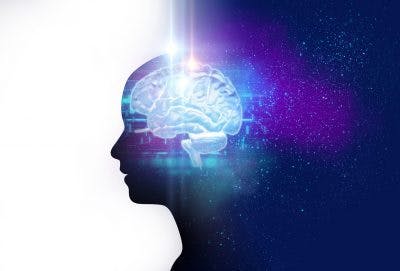
Neuromuscular re-education seeks to retrain the nervous system to produce normal movement.
After a brain injury, the relationship between the brain and muscles can become disrupted. Fortunately, using specific retraining methods that activate neuroplasticity in the brain enhances those new neural connections. In doing so, neuromuscular re-education can improve the function of your nervous system and the way it produces movement.
Most of it will involve practicing specific movements, such as moving your arms or standing up. The more you practice, the more you reinforce those pathways, which strengthens the connection between the brain and muscles. So be prepared to do lots of exercises.
Want 25 pages of TBI recovery exercises in PDF form? Click here to download our free TBI Rehab Exercise ebook now (link opens a pop up for uninterrupted reading)
2. Passive Exercise
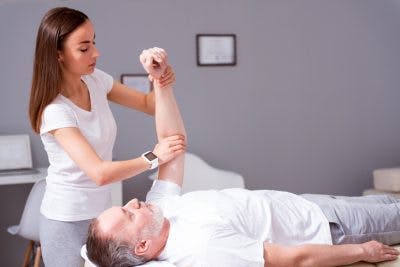
Passive exercise is another physical therapy intervention that therapists often use to help individuals with traumatic brain injuries regain movement.
Sometimes the neural connections between the brain and muscles are severed after an injury, making it almost impossible to move the affected muscles. Doctors call this brain injury paralysis. To treat this condition, a physical therapist might prescribe passive exercise.
Passive exercise refers to when someone else (such as a physical therapist or trained caregiver) moves your affected body parts for you. Even though you are not actively performing the movement, the movement itself is enough to stimulate the brain.
By consistently stimulating the brain through passive exercise, individuals may be able to gradually develop movement in their affected muscles.
3. Home Exercise

Consistent exercise is really the heart of brain injury rehabilitation. It’s what will allow you to regain function and make a good recovery. That’s why most physical therapists urge their patients to continue exercising even when they are not at the clinic.
Luckily, there are at-home physical therapy tools, such as FitMi, that can help you do just that. FitMi guides you through the best PT exercises in a fun and engaging way that encourages you to perform the repetitions you need to improve motor control.
4. Vestibular Training
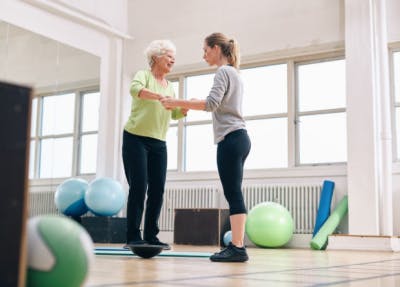
After brain injury, individuals may experience balance problems. To help you regain your balance, a physical therapist may have you participate in vestibular training.
During vestibular training, your physical therapist will perform a series of vision and balance tests to determine if your issues are stemming from the inner ear (a part of the vestibular system). Based on the results, they’ll create a customized exercise plan to address your specific vestibular issue.
Vestibular training may also involve learning various balance techniques to help reduce your risk of falls and prevent further injury.
5. Gait Training
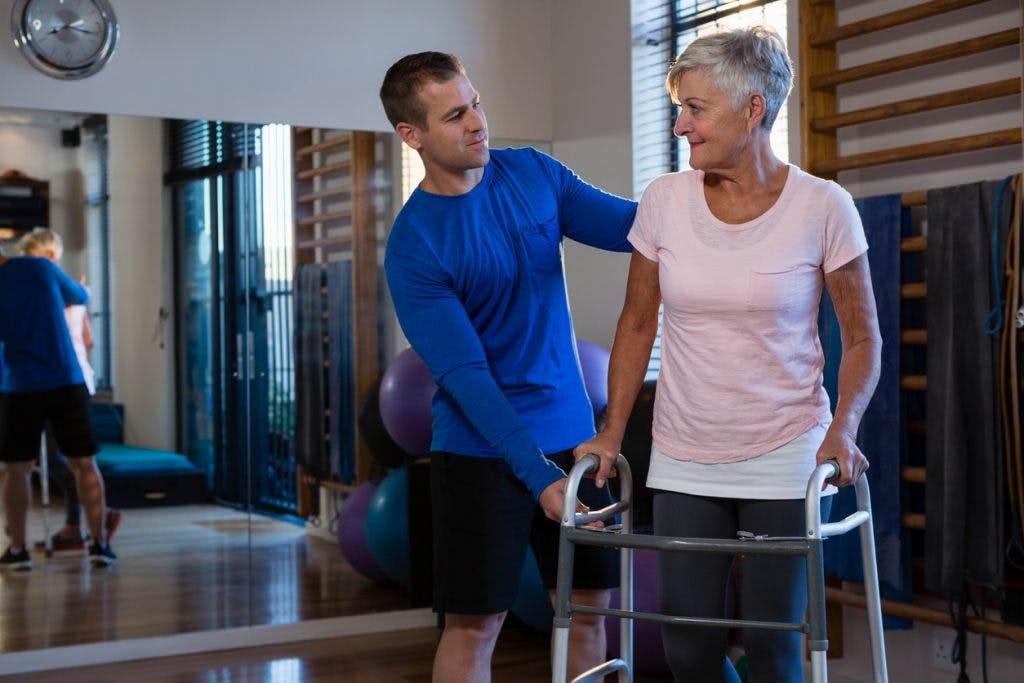
To regain the ability to walk, physical therapy may involve task-specific gait training.
Task specificity is an important aspect of engaging neuroplasticity. It means that in order to improve an action, you must directly practice it. Therefore, to improve your walking ability, therapists will have you practice walking motions, also known as gait training.
Gait training begins with assisted forms of walking first, such as walking on a treadmill with a body harness. As your strength improves, you will work your way up to using a walker or cane, until you can walk unsupported.
6. Constraint-Induced Movement Therapy (CIMT)

Constraint-induced movement therapy (CIMT) is a physical therapy intervention designed to prevent learned non-use after a traumatic brain injury.
Learned non-use occurs when a person becomes overly dependent on their unaffected body parts and consequently, avoids using their affected body part(s).
For example, if a brain injury has affected a patient’s right hand, they might get used to using their left hand for everything. Unfortunately, if this goes on too long, motor control in the right hand may deteriorate until it is effectively useless.
CIMT attempts to thwart this process by forcing the patient to use their affected limbs. It typically involves constraining the unaffected arm with a strap or mitt. Consistently practicing exercises with the affected arm may help promote neuroplasticity to regain motor control.
7. Aquatic Therapy
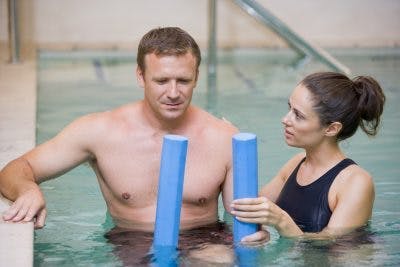
Aquatic therapy is a physical therapy intervention that takes place in a heated pool. During an aquatic therapy session, a therapist works one-on-one with the patient while the patient is floating or standing in water.
The water’s buoyancy allows a person to participate in physical therapy with reduced pressure on the joints. This allows the individual to focus on perfecting their form. In addition, the water’s viscosity offers more resistance to movement, which helps increase muscle strength and endurance.
Physical Therapy for Traumatic Brain Injury
Participating in physical therapy interventions can help individuals regain their mobility after traumatic brain injury. By focusing on repetitive practice of targeted exercises, individuals can activate neuroplasticity and encourage the brain to make adaptive changes.
We hope this article helped you get a better idea of the various physical therapy interventions that may be involved in the traumatic brain injury rehabilitation process.

